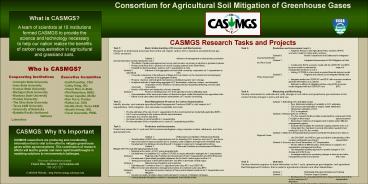Task 1:Basic Understanding of Processes and Mechanisms. - PowerPoint PPT Presentation
1 / 1
Title:
Task 1:Basic Understanding of Processes and Mechanisms.
Description:
Effects of soil water status ... Prediction and Assessment. ... This coordination of research efforts will lead to greater and more rapid breakthroughs in modeling ... – PowerPoint PPT presentation
Number of Views:63
Avg rating:3.0/5.0
Title: Task 1:Basic Understanding of Processes and Mechanisms.
1
Consortium for Agricultural Soil Mitigation of
Greenhouse Gases
What is CASMGS? A team of scientists at 10
institutions formed CASMGS to provide the
science and technology necessary to help our
nation realize the benefits of carbon
sequestration in agricultural and grassland
soils.
CASMGS Research Tasks and Projects
- Task 1 Basic Understanding of Processes and
Mechanisms. - Research on biophysical processes that control
soil organic carbon (SOC) dynamics and greenhouse
gas (GHG) emissions. - Subtask 1 Influence of management
on plant primary production and transformation of
plant material into soil C - The effects of grazing management and woody plant
invasion on primary production in grassland
systems. - Primary production and C dynamics of several
cropping systems in the Great Plains. - Potential for plant breeding to enhance soil C
sequestration in soils. - Subtask 2 Influence of soil aggregation and
microbial community composition on C
sequestration in agricultural soils - Cross-site comparison of the influence of tillage
and crop rotation on the chemical and
microbiological properties of soil aggregate
fractions. - Physical, chemical, and biological mechanisms
controlling long-term soil C storage. - Analytical methods of determining aggregate SOC
fractionation molecular, isotopic, and elemental
composition of SOC fractions microbial yield
and substrate partitioning and microbial
community composition. - Kinetics of formation and destruction of humic
materials. - Subtask 3 Factors controlling losses of C from
agricultural soils to infiltrating water - Characterization of the amount and nature of
dissolved organic matter that leaches from
agricultural soils. - Effects of soil water status and limestone
amendments on C exports via leaching. - Task 2 Best Management Practices for Carbon
Sequestration. - Identify, develop, and evaluate agricultural Best
Management Practices (BMPs) with respect to C
sequestration, GHG mitigation, and associated
co-benefits and costs.
- Task 3 Prediction and Assessment (cont.)
- Adapt the Resource and Agricultural Policy
Systems (RAPS) economic model for carbon policy
analysis. - Subtask 6 Model Comparisons and
Databases for Integrated Assessment Models - Subtask 7 Integrated Assessments of GHG
Mitigation at Field and Farm Scale - Combine the RAPS economic model with the
CENTURY and EPIC physical models to estimate the
impact of management decisions on soil C. - Linking CSTORE to a farm-level
economic/financial decision model. - Subtask 8 Regional and national Level
Integrated Models and Policy Assessment - Integrate results from CENTURY and EPIC with
economic models to generate information on a
national scale. - Estimate co-effects of mitigation policies
using RAPS economic model integrated with the
CENTURY and EPIC. - Task 4 Measuring and Monitoring.
- Develop mechanisms to estimate and verify changes
in soil carbon and greenhouse gas emissions in
the context of likely changes in policy and land
use. - Subtask 1 Estimating SOC at Multiple
Scales - Fine, field-scale modeling of variability in
SOC estimates. - Soil survey-scale estimates of organic matter
distribution. - Whole-farm estimates of SOC.
- SOC in rangelands.
- Subtask 2 Measuring Fluxes of GHGs
Who is CASMGS?
- Cooperating Institutions
- Colorado State University
- Iowa State University
- Kansas State University
- Michigan State University
- Montana State University
- Purdue University
- The Ohio State University
- Texas AM University
- University of Nebraska
- Battelle-Pacific Northwest National Laboratory
- Executive Committee
- Keith Paustian, CSU
- Cathy Kling, ISU
- Chuck Rice, K-State
- Phil Robertson, MiSU
- Susan Capalbo, MoSU
- Ron Turco, Purdue
- Rattan Lal, OSU
- Neville Clark, Texas AM
- Shashi Verma, UNL
- Cesar Izaurralde, PNNL
CASMGS Why Its Important CASMGS researchers
are producing and coordinating information that
is vital to the effort to mitigate greenhouse
gases within agroecosystems. This coordination of
research efforts will lead to greater and more
rapid breakthroughs in modeling solutions to
environmental challenges. For more information
contact Chuck Rice, Director
cwrice_at_ksu.edu 785-532-7217
CASMGS Website http//www.casmgs.colostate.edu































